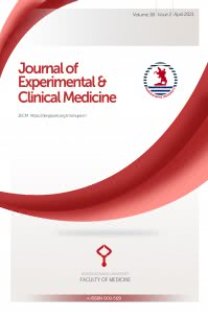Çocuklarda kolestatik tip hepatit A enfeksiyonu
Hepatit A, Geriyedönük çalışma, Çocuk, Ursodeoksikolik asit, Kolestaz, Bilirubin, Sarılık
Cholestatic hepatitis A infection during childhood
Hepatitis A, Retrospective Studies, Child, Ursodeoxycholic Acid, Cholestasis, Bilirubin, Jaundice,
___
1. Kanra G, Kara A. Hepatit A virüsü ve hepatit A. Katkı Pediatri Dergisi 1998; 19: 577-593. 2. Ciocca M. Clinical course and consequences of hepa¬ titis A infection. Vaccine 2000;18(suppl 1): 71-74. 3. Maier KP. Clinical significance of cholestatic viral he¬ patitis. Z Gastroenterol 1993;31(suppl 2): 71-72. ' 4. Gordon SC, Reddy KR, Sehiff L, et al. Prolonged intra-hepatic cholestasis secondary to acute hepatitis A. Ann Intern Med 1984; 101: 635-637. 5. Molina Merino A, Martinez-Huguet F, Asensi Monzo MT, et al. Cholestatic-type hepatitis in childhood. An Esp Pediatr 1998; 49: 253-256. 6. Corpechot C, Cadranel JF, Hoang C, et al. Cholesta¬ tic viral hepatitis A in adults. Clinical, biological and histopathological study of 9 cases. Gastroenterol Clin Biol 1994;18: 743-750. 7. Stiehl A, Rudolph G, Raedsch R, et al. Ursodeoxycho- lic acid-induced changes of plasma and urinary bile acids in patients with primary biliary cirrhosis. Hepa- tology 1990; 12: 492-497. 8. Galle PR, Theilrriann L, Raedsch R, et al. Ursodeoxyc- holate reduces hepatotoxicity of bile salts in primary human hepatocytes. Hepatology 1990:12:486-491. 9. Fabris P, Tositti G, Mazzella G, et al. Effect of ur-sodeoxycholic acid administration in patients with acute viral hepatitis: a pilot study. Aliment Pharmacol Ther 1999; 13:1187-1193. 10. Galsky J, Bansky G, Holubova T, et al. Effect of ur- sodeoxycholic acid in acute viral hepatitis. J Clin Gastroenterol 1999; 28: 249-253. 11. Koçak N, Saltık İN. The effect of ursodeoxycholic acid in children with prolonged hepatitis A virus infection that may be a trigger factor for autoimmune hepatitis. Am J Gastroenterol 2001; 96: 610-611. 12. Dinler G, Koçak N, Özen H, et al. Ursodeoxycholic acid treatment in children with Byler disease. Pediatr Int 1999; 41: 662-665. 13. Williams R, Billing BH. Action of steroid therapy in jaundice. Lancet 1961; 2: 392-396. 14. KoffRS. Hepatitis A. Lancet 1998; 351: 1643-1649. 15. Sehiff L. The use of steroids in liver disease. Medicine (Baltimore) 1966; 45: 565-573. 16. Rachima CM, Cohen E, Garty M. Acute hepatitis A: Combination of the relapsing and the cholestatic forms, two rare variants. Am J Med Sci 2000; 319: 417-419. 17. Glikson M, Galun E, Ören R, et al. Relapsing hepati¬ tis A. Review of 14 cases and literature survey. Medicine (Baltimore) 1992; 71: 14-23. 18. Sehiff ER. Atypical clinical manifestations of hepatitis A. Vaccine 1992; 10(suppl 1): 18-19. 19. Teixeira MR Jr, Weller IV, Murray A, et al. The pat¬ hology of hepatitis A in mart. Liver 1982; 2: 53-60.20. Ramonet MD, Gomez S, Morise S, et al. Acute hepati¬ tis A virus. Association with fulminant hepatic failure and autoimmune hepatitis in pediatric population. J Pediatr Gastroenterol Nutr 2000; 31(suppl 2): 116-117. 21. Hilzenrat N, Zilberman D, Klein T, et al. Autoimmune hepatitis in a genetically susceptible patient: is it trig¬ gered by acute viral hepatitis A? Dig Dis Sci 1999; 44: 1950-1952. 22. Akbulut A. HAV enfeksiyonu. Kılıçturgay K, Badur S. Viral Hepatit 2001 (1. Baskı). Viral Hepatitle Savaşım Derneği Yayını, 2001: 70-71.
- ISSN: 1300-2996
- Yayın Aralığı: Yılda 4 Sayı
- Başlangıç: 2018
Behçet hastalarında saç çinko ve bakır eser elementlarinin araştırılması
İ. Serhat KOCAMANOĞLU, Deniz KARAKAYA, Sibel BARIŞ, Bengi ŞENER, Ayla TÜR
Propofol enjeksiyon ağrısının önlenmesinde ondansetron ve lidokainin karşılaştırılması
EBRU KELSAKA, Sibel BARIŞ, Şebnem TEPE, Binnur SARIHASAN, Bengi ŞENER, Ayla TÜR
Low dose spinal anesthesia for caesarean section in a patient with peripartum dilated cardiomyopathy
İsmail Serhat KOCAMANOĞLU, Sibel BARIŞ, Deniz KARAKAYA, Ayla TÜR, Haydar ŞAHİNOĞLU, Emre ÜSTÜN, Bengi ŞENER, Mehmet ÇETİNKAYA
Göğüs duvarı tümörlerinde cerrahi tedavi deneyimlerimiz
Ahmet BAŞOĞLU, Sedat DEMİRCAN, BURÇİN ÇELİK, Ali Osman AKDAĞ, Ayşen Taslak ŞENGÜL
Çocuklarda kolestatik tip hepatit A enfeksiyonu
Ayhan Gazi KALAYCI, FADLİ DEMİR, Hasan YILDIRIM, Şükrü KÜÇÜKÖDÜK
Meningokoksemik septisemiye bağlı cilt nekrozları: Olgu sunumu
Ahmet DEMİR, Hayati AKBAŞ, Ethem GÜNEREN, Lütfi EROĞLU, İbrahim ORAK
Cengiz ÇOKLUK, Mustafa ARAS, Alparslan ŞENEL, Ömer İYİGÜN, ARİF ÖNDER, Cemil RAKUNT, Fahrettin ÇELİK
